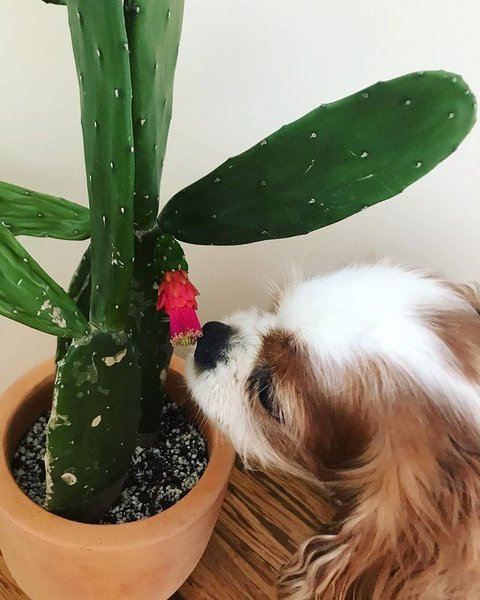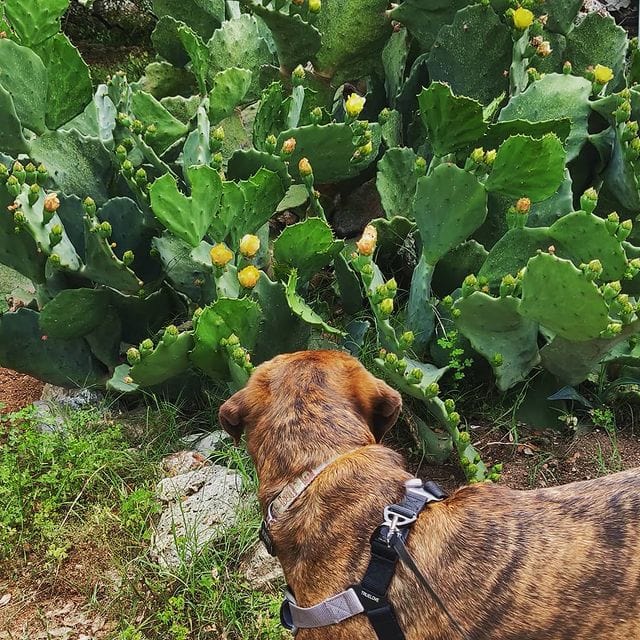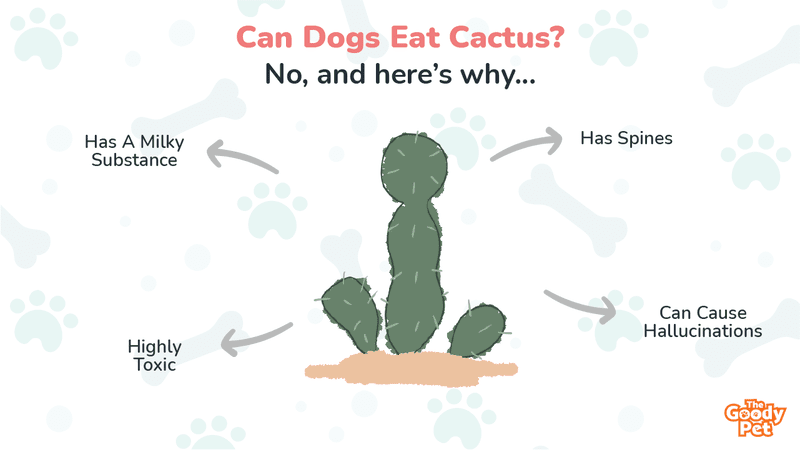Having cacti around your home is not only beautiful but also of tremendous health benefits. However, if you are a parent of one or two pups, you already know how adventurous they can be and eat just about anything. But can dogs eat cactus?
Yes, dogs can safely eat cactus and its flesh. The major and only concern you may have if your furry friend has ingested this succulent plant is its spines. Some cacti’s spines can be hard and sharp, thus inflicting injuries down the throat or face of your canine. But, do take note of the known poisonous cacti, like Cholla.
That said, since these xerophytic plants portend dangers to your pups in a way, it is good to learn more about them and discover which variants you should keep away from your dogs. So let’s begin by looking into the appropriateness of a cactus as food for dogs.
Is Cactus Bad For Dogs To Eat?

Cactus is not an ideal food for dogs. There are better sources of nutrients for canines aside from cactus. However, if ingested by your canine, most cacti will do them little or no harm.
Most cacti are excellent sources of fiber, potassium, and other minerals which can be helpful to dogs. But due to the tendency of pups to develop stomach irritation and psychological imbalance after eating this water-conserving plant, you should keep it far from their reach.
While most cacti are safe for dogs, some are poisonous. They can cause your pooch to have gastrointestinal disturbances, diarrhea, or vomiting. But which cactus is toxic to dogs? Find out in the section below.
Which Cactus Is Poisonous To Dogs?
A few cacti or cacti-mimicking plants, such as those of the Euphorbia family, are toxic to dogs. Common symptoms of their toxicity include nausea, psychotic imbalance, and irregular breathing.
More specific examples of toxic cacti are listed below:
- Pencil Cactus (Euphorbia tirucalli) – This plant contains a milky substance that can cause dermal, ocular, and gastrointestinal injury to your furry friend.
- Peruvian Torch Cactus (Echinopsis Peruviana) – This plant has large spines and is infamous for causing hallucinations and other varied disorders.
- San Pedro Cactus (Echinopsis Pachanoi) – It has attractive spines and flowers but contains psychedelic alkaloids such as mescaline that can cause hallucination.
- Peyote Cactus (Lophophora williamsii) – Though spineless, this cactus can cause a psychotic breakdown if dogs overconsume the plant. It also causes irregular breathing, papillary dilation, heart rate, and blood pressure.
- Canary Islands Cactus (Euphorbia canariensis) – It is highly toxic, and its milky sap irritates the eyes and skin.
- The Barrel cactus (Echinocactus grusonii) – Its ribs contain poisonous saps that irritate pups’ skin. Its spines can also inflict dermal injury.
- Saguaro (Carnegiea gigantean) – Its numerous pointy and sharp spines will definitely inflict wounds on your pooch’s skin.
- Silver Dollar (Crassula arborescens) – When pricked, this cactus causes nausea, vomiting, and sometimes tremor.
- Cholla (Cylindropuntia) – It can shoot needles that are poisonous to dogs and humans.
The above cactus species are not only toxic to dogs but also to human beings. As such, when planning to buy this plant for your home decorations, check to rule out any of them.
Can Dogs Eat Succulents?
Yes, dogs can eat succulents. Except for a few, many of them will not cause serious health concerns to your canines.
The succulents you should keep away from your home if you parent a dog include:
- Aloe vera
- Rubber
- Jade plant
- Panda plant
- Kalanchoe
- Snake plant
What Cacti Are Safe For Dogs?

Christmas and Thanksgiving cacti are safe for dogs. These cacti species are known for their attractive winter flowers and pinkish blooms, which are perfect for holidays.
Another safe cactus for dogs is the Opuntia or prickly pear cactus. Native to Mexico, this species is cultivated for food and often used as a natural sweetener.
However, since all cacti species have spines, some of which are sharp and strong, you should endeavor to keep your indoor plants away from your furry friends.
Where they have inadvertently eaten a toxic cactus, you can do a few things about it. See the next section for insights.
What If My Dog Eats My Cactus?
If your dog already ate your cactus, the first thing is to determine whether the cactus is known to be poisonous. That is why knowing the name of any plant you cultivate indoors is vital.
If your cactus is not listed among the poisonous ones above, you can run a quick online check on it to confirm its toxicity.
Whatever your findings, your best bet is to visit the closest vet clinic for proper examination and treatment. However, knowing the name or description of the cactus your dog consumed can help the vet nail the best treatment option quickly.
As already mentioned, your greatest concern when your four-legged friend runs in with a cactus in their mouth is the spines. The chances are that these pointy spines are already deep into their skins and will soon manifest in various symptoms. As such, you have to remove these spines quickly and treat their wounds.
While on a hiking trip where there are no emergency vet clinics around, you will have to remove the spines from your pooch by yourself. But how do you get a cactus’ spines out of a dog’s body? We’ll take a look at that next.
How Do You Get Cactus Out Of A Dog?
In addition to having the right tools, you need an extra person to help remove cactus spines from your dog successfully. Having an additional pair of hands can help hold the dog still while you are working on the removal task.
Essential tools for this procedure include a clean towel, sterilized tweezers, and antibiotic ointment. While someone helps you to hold the dog still, remove the spines by using the tweezer.
Never attempt to remove those sharp objects with your hands because they can injure you too. You are to pull the spine in the direction of your pup’s fur, not in the opposite; it will help minimize bleeding.
You can expect a few blood stains here and there as you pull out the spines. Clean such with your towel and apply an antibiotic ointment immediately. If everything is done well, bleeding should stop in a few minutes.
If healing does not proceed as expected, especially within 2 to 3 days, you should not hesitate to contact a vet immediately. Also, if you notice any escalated distress, fever, loss of appetite, or discomfort in your canine after this procedure, you need a professional to help out.





